
I know! Looks so harmless doesn’t it?
Here are my 6 reasons not to drink milk, more specifically milk from a cow. I gave up drinking milk many years ago after doing an elimination diet and finding out quite dramatically how it was one of the major causes of my eczema (see my story). I was running a coffee shop at the time so I was surrounded by the stuff which made it slightly more challenging, but with the wonderful alternatives we have access to nowadays I stuck with it and now I wouldn’t dream of drinking the stuff, it tastes like drinking pure fat! Amazing how your tastebuds evolve when you make big diet changes.
6 reasons to stop drinking milk
1. Digestive issues– lactose intolerance, enzymes and pasteurisation

lactose intolerance- This is a big one and one of the main reasons people are moving away from dairy. Today more then 90% of people have some degree of lactose intolerance with some people, mainly of African, Asian or Mediterranean descent not able to digest it at all. Lactose is a natural milk sugar found in milk. It is broken down by the enzyme Lactase into the simple sugars, glucose and galactose, to be absorbed into the blood stream. People who are intolerant simply do not have enough Lactase. Infants are born with plenty of Lactase befitting their diet. As other food is introduced Lactase production decreases. Generally, there is still enough to cope with some dairy, but if not, this is labelled as primary lactose intolerance. I would argue that this is a completely natural bodily process and that if we look to other animal species, no other mammal continues drinking milk once weaned, especially not that of another species.

Before the rearing of livestock started, around 10,000 years ago, humans could not digest lactose into adulthood. Obviously at this time, the genes that started to mutate to enable lactase persistence into adulthood, gave these tribes an advantage as the extra calories meant they could better survive famines, and may also have been better conquerors, aiding the spread of their civilisations and cultures. With so much abundance in energy rich foods perhaps this evolutionary ability is now somewhat outdated and causing more harm then good.
Enzymes and pasteurisation- Another factor I believe is that fresh milk, straight from the cow, actually contains friendly bacteria that facilitate the creation of lactase in the intestine. 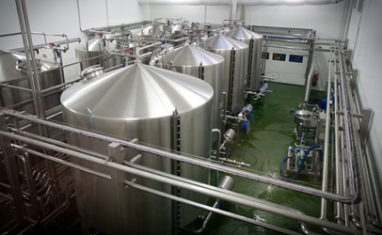 Pasteurisation, which is basically heat treatment, kills these friendly bacteria. This practise started to become widespread in the US and UK in the 1950’s. It was done because of the high risk of contaminated milk getting to market due to unhygienic practises within the dairy industry. Generally, it would seem, as soon as something gets industrialised and away from the natural way of things, bacteria want to proliferate and then new methods of human control have to be established. Much like the rudimentary treatment of drinking water with chlorine.
Pasteurisation, which is basically heat treatment, kills these friendly bacteria. This practise started to become widespread in the US and UK in the 1950’s. It was done because of the high risk of contaminated milk getting to market due to unhygienic practises within the dairy industry. Generally, it would seem, as soon as something gets industrialised and away from the natural way of things, bacteria want to proliferate and then new methods of human control have to be established. Much like the rudimentary treatment of drinking water with chlorine.  So, if there were health benefits from drinking milk, with pasteurisation that can no longer be an argument. Check out my article on beneficial bacteria and how key enzymes are in digestion and overall health. Probiotics: Why we need them
So, if there were health benefits from drinking milk, with pasteurisation that can no longer be an argument. Check out my article on beneficial bacteria and how key enzymes are in digestion and overall health. Probiotics: Why we need them
2. Homogenisation– leaky guy, saturated fat and heart disease
Milk is very high in fat. Great for the hunter gatherers of old who needed a lot of energy for an active lifestyle. However, in the modern West we are mostly sedentary and consume way more fat then we need resulting in a worldwide obesity epidemic. More the 2/3rd of adults in the UK and US are considered overweight or obese. Milk is ideal to fatten up a small calf, reaching adult weight of around 1500lb for a female Holstein in less then 2 years. This is completely different to how a human grows and develops.  This problem is made more acute with milk due to the process of homogenisation. Without it a lot of the larger fat globules just pass straight through our digestive system. This treatment breaks down the fat in the milk producing smaller, uniform molecules resulting in a uniform product that doesn’t settle. These molecules in their smaller form can actually travel through the intestinal wall and into the blood stream creating fatty deposits in the arteries and around the heart, the cause of heart disease, another Western epidemic.
This problem is made more acute with milk due to the process of homogenisation. Without it a lot of the larger fat globules just pass straight through our digestive system. This treatment breaks down the fat in the milk producing smaller, uniform molecules resulting in a uniform product that doesn’t settle. These molecules in their smaller form can actually travel through the intestinal wall and into the blood stream creating fatty deposits in the arteries and around the heart, the cause of heart disease, another Western epidemic.
3. Acidic versus Alkaline- minerals and the myth of calcium

Milk is an acidic food with a Ph of around 6. The body maintains a Ph of 7.4 which is slightly alkaline. The breaking down of acidic food by oxidation creates waste products with a high acidic load requires neutralising before it reaches the kidneys. This is done by adding alkalising minerals. The body struggles less if the diet is high in alkalising food, if not then it has to find these minerals from one of its stores. One such storage area is our bones, particularly our joints where we have the most vessels to extract minerals. This is where we have the paradox of the calcium debate. Calcium is a powerful acid neutraliser and is actually leached from our bones and joints to aid in the process of alkalising along with other minerals. It is then washed out in our urine. With a heavy acidic load we are constantly depleting our stores of alkalising minerals which can lead to disease such as osteoporosis. So in actual fact, milk does not help us grow strong teeth and bones as we are using up our stores of it to digest it! We barely absorb the calcium in milk especially if it has been pasteurised.
Eating a high alkaline diet is a good start with many veggies falling into the category but if you are eating a lot of meat and dairy this really wont help much as you would need to eat so much of it in order to make a difference. 
Deep Green Alkalising blend is a potent remineralising blend which provides high levels of alkalising minerals to help the body cope with an acidic diet or used as a supplement for people going dairy free who would like to remineralise and strengthen their damaged system.
4. Animal cruelty- the ethics of industrialised farming
The vast majority of our milk now comes from huge dairy farms where the cows are often kept indoors, in cramped conditions standing on concrete in their own excrement. 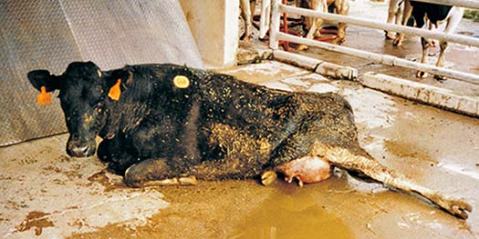 Because of these conditions there is widespread preventative antibiotic use to prevent spread of bacteria and disease. The dairy cows are artificially inseminated every year and so they are generally either pregnant or lactating. To bring the cows into their next heat cycle they are injected with hormones taken from pregnant horses.
Because of these conditions there is widespread preventative antibiotic use to prevent spread of bacteria and disease. The dairy cows are artificially inseminated every year and so they are generally either pregnant or lactating. To bring the cows into their next heat cycle they are injected with hormones taken from pregnant horses.

veal calfs
When they give birth the carves are generally taken from the new mothers within the same day, obviously very distressing for both mother and baby. The males are either disposed of or sold into the veal trade where trips of hundreds of miles are not uncommon for these new borns before slaughter. Females are kept in cramped pens until they can be inseminated.

A mother and babe receiving a cow lick, how things used to be…
A cow left to suckle with its mother would only take a few litres a day, in the modern dairy, 50 litres/day is not uncommon. The profit margins are so slim that leaving a calf with its mother, even if better well being is the result, is argued as being not cost effective.

Grossly deformed Holstein dairy cow
Inbreeding has selected for high yield over many generations so cows are struggling along with huge udders. Producing far more milk then their bodies can bare. The excessive twice a day milking regime often results in painful mastitis infection. The hard life and constant production these cows have to endue, whether it be babies or milk, means they generally are taken out of service and put down before they are 5 years old, exhausted and spent long before there 20 year natural life expectancy.
5. Sustainability– feed- rainforests- water-methane
A key point in the industrialisation of dairy farmers in the US was when the federal government fixed the price of milk. This meant that to make a profit farmers had to produce more milk.
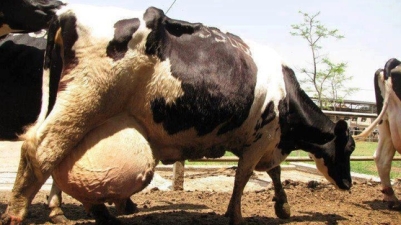
Holstein dairy cow after generations of selective breeding
To do this they started feeding with high protein feeds such as corn and soya. At the same time selective breeding was producing cows with higher yields, favouring the corn-fed black and white Holstein. These cows can eat up to 10o pounds of feed per day when milking. With bigger herds with bigger demands farmers could long produce all their own feed and so became grain buyers but were struck with major financial difficulties when grain prices rose. This resulted in many smaller operations going under or being bought out by the big multi-nationals who could absorb such rises and also buy in huge quantity from cheaper sources abroad.

Soy plantation in the Amazon rainforest, Brazil
Thats where the Amazon comes in. Brazil overtook the US for biggest producer of soya in 2012. Between 70-90% of world soy production goes to feed livestock. Huge swathes of rainforest have been clear cut to facilitate this, a lot of it illegally with huge operations often taking land from local farmers by force. Some progress has been made to protect virgin forest with the Greenpeace led Soya Moratorium, a voluntary agreement ensured that traders do not purchase soya grown in the Amazon on land deforested after 2006 but ever year there is huge pressure for its demise. I also touch on this on my earlier article caring isn’t convenient
Cows also need a lot of water, especially when digesting such high protein foods.

Dairy flushing system at work
Then you have the agricultural demands for the feed and the automatic flushing systems within the dairies (up to 150 gallons/cow/day) It is estimated that it takes 1,000 litres of water to produce one litre of milk, which is roughly double what it takes to produce a litre of almond milk.
There is also the issue of the pollution. Cows produce a lot of excrement and in a high volume factory farm there simply is too much of it to use sustainably and safely on the land, as was the practise on smaller, mixed agriculture farms.
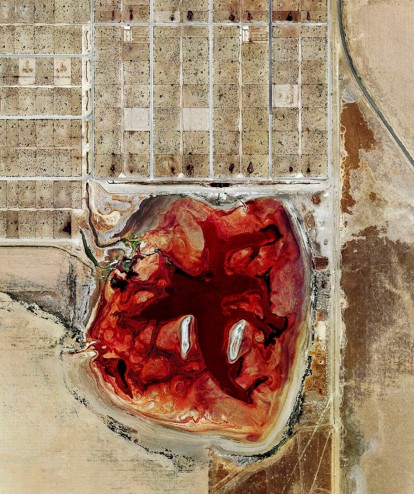
The boil like scar of a manure lagoon at a cattle ranch in the USA
The US experienced a 64% rise in the amount of manure that could not be absorbed by the soil. Often stored in vast lagoons, these can leak or rupture, polluting surrounding soil and water. Major storms can result in overflows. A single cow can produce up to 120 lbs of liquid manure/day. One dairy farm with 2,500 cows produces as much waste as a city of 411,000 residents. Consider that the largest dairy farm up for construction in the world is in Vietnam and hopes to farm 32,000 cows. Where does all this waste go? The methane cows produce by farting and burping is a huge contributing factor of greenhouse gases with each cow releasing between 70-150kg of methane per year into the atmosphere. Then you have all the fossil fuels used in fertilisers, pesticides and for transporting manure, feed and the final product internationally. A heavy burden indeed.
6. Healthy alternatives! Better for everyone
So after all that bad news lets refocus, on the good! As more people demand dairy-free alternatives the market has been flooded with new alternatives to replace dairy milk with plant and nut based formulas.

6 reasons not to drink milk? Here’s 8 reasons to try the alternatives!
Many of the big brands are simply profit driven and filled with fillers and additives so make sure to read the ingredients thoroughly to really get the benefit from making the switch.
- Avoid milks made from soya which has other associated health issues as well as the environmental problems discussed above.
- Sugar- sweetened milk alternatives are just setting you up for health problems in the future, such as diabetes and in fact non-sweetened versions are naturally sweet. 1 glass of the chocolate Alpro contains 20g of sugar, almost as much as a glass of coke!
- Carrageenan– A texturizing additive derived from seaweed. Regarded as safe by the FDA, although some people report gastro-intestinal issues
- Vitamin A Palmitate– Many ready-to-drink products are fortified with synthetic vitamins. There is some controversy surrounding vitamin A palmitate, as it may be sourced from palm plantations that are damaging to ecosystems as well as a possible carcinogenic.
- Look out for preservatives, colours, flavourings, all possible endocrine disruptors.
- Choose Organic versions
In the UK I rate 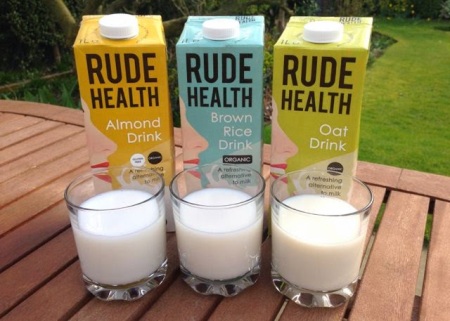 Rude Health for almond milk or oat, Oatly, Pacific and Good Hemp I avoid the bigger brands. Silk and Almond Breeze are both the target of a class-action lawsuit claiming that they only contain 2% almonds. In the US I have tried New Barn Almond Milk which had a high percentage of Almonds and was really creamy.
Rude Health for almond milk or oat, Oatly, Pacific and Good Hemp I avoid the bigger brands. Silk and Almond Breeze are both the target of a class-action lawsuit claiming that they only contain 2% almonds. In the US I have tried New Barn Almond Milk which had a high percentage of Almonds and was really creamy.
Better yet, make your own!!
Its actually really easy to make your own nut or oat milk. Simply soak a handful of whatever, almonds take longer. Then blend up with a pint of water and strain through a muslin, squeezing to get all the remnants. If I’m making a smoothie with the milk I don’t even drain it. if you want a slightly more sweet milk blend in a couple of dates after straining and perhaps a pinch of pink himalayan sea salt.
Simply soak a handful of whatever, almonds take longer. Then blend up with a pint of water and strain through a muslin, squeezing to get all the remnants. If I’m making a smoothie with the milk I don’t even drain it. if you want a slightly more sweet milk blend in a couple of dates after straining and perhaps a pinch of pink himalayan sea salt.
If you need any advice with replacing your daily milk, going for a different source of Protein, making your own nut milks or, remineralising with powerful superfoods, please get in touch!
Many blessings!
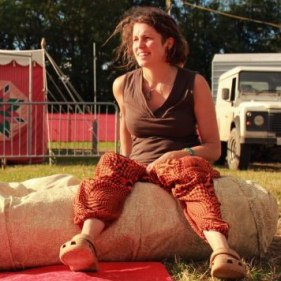
Samantha x
samantha@whitedragonorganics.com